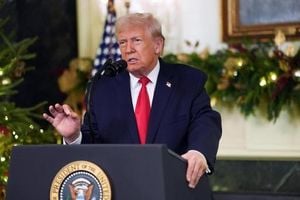The road to the 2028 presidential election is already taking shape, but if the latest data and political maneuvering are any indication, the Democratic Party faces a mountain of uncertainty—especially in New Hampshire, a state famous for its kingmaking primary. According to a November 2025 survey by the Saint Anselm College Survey Center at the New Hampshire Institute of Politics, Democrats are entering the next cycle with no clear frontrunner, while Republicans appear to be coalescing around a single candidate.
The numbers tell a story of fragmentation for Democrats. Former Transportation Secretary Pete Buttigieg leads the hypothetical 2028 Democratic primary field in New Hampshire with just 28 percent support among registered party voters. Not far behind is California Governor Gavin Newsom, who clocks in at 24 percent. Former Vice President Kamala Harris, once considered a rising star, trails with only 6 percent, while Illinois Governor JB Pritzker and Senator Cory Booker (D-NJ) each garner 4 percent. Pennsylvania Governor Josh Shapiro sits at 3 percent, and all other potential candidates—including Senator Amy Klobuchar of Minnesota—register at 2 percent or less. It's a crowded field, but no one commands anything close to majority support. The survey, published November 25, 2025, highlights a party still searching for its next standard-bearer.
Contrast that with the Republican side of the aisle, where the situation is far more settled. Vice President JD Vance enjoys a commanding lead, with 57 percent of surveyed New Hampshire Republicans indicating they'd back him in a primary. The next closest contender, Secretary of State Marco Rubio, trails far behind at 9 percent. Florida Governor Ron DeSantis garners 7 percent, while businessman Vivek Ramaswamy, former ambassador Nikki Haley, and DNI Director Tulsi Gabbard each secure 4 percent. Senators Ted Cruz (R-TX) and Virginia Governor Glenn Youngkin scrape by with just 1 percent apiece. Two percent of respondents are considering "other" candidates, and a notable 10 percent remain undecided. The numbers suggest a party rallying behind a successor, in stark contrast to the Democrats’ fractured field.
But what’s driving voters as they look ahead to 2028? The Saint Anselm survey found that the top issue for New Hampshire voters is elections and democracy, cited by 23 percent of respondents. The economy and inflation come in second at 17 percent, followed closely by affordability at 16 percent. Other key concerns include government spending and taxes (11 percent), health care (10 percent), and border security (6 percent). Remaining issues register with 4 percent or less, painting a picture of an electorate focused on bread-and-butter topics as well as the integrity of the political system itself.
Against this backdrop, some Democrats are sounding the alarm about the party’s messaging and strategy. Kentucky Governor Andy Beshear, who has quietly built a reputation as a pragmatic centrist, is among those pushing for a course correction. In 2025, Beshear has made a concerted effort to expand his national profile, launching a podcast, making the rounds on national press, and even flying to London for trade talks. He’s also taken his message to early primary states like New Hampshire and South Carolina, fueling speculation about a possible 2028 presidential run—even if he insists no decision has been made.
In a November 24, 2025, opinion piece for The Washington Post, Beshear argued that Democrats need to do more than just talk about affordability if they want to win back voters who have drifted away in recent years. "Democrats should be the party that will make it possible to build a better life — one in which you’re not just making ends meet but setting your family up for long-term success," Beshear wrote. He pointed to his own record in Kentucky, where he helped open a paper mill in a former coal town, an effort he described as having “resurrected the American Dream for 320 families.” He added, "By focusing on reviving it, Democrats can win back voters who have been leaving the party in droves."
Beshear hasn’t shied away from criticizing his party’s approach to messaging. He’s argued that Democrats need to talk about issues in plain language that resonates with everyday Americans. "We’re not going to win the messaging battle if we say that Trump’s policies make people ‘food insecure,’” he wrote. “No, they make people hungry. Kentucky was hit hard by the opioid epidemic. I didn’t lose friends and acquaintances to ‘substance use disorder’; I lost them to addiction. Addiction is hard, it’s mean, and it kills people. So when people triumph over it, we should give them the credit they deserve by calling it what it is." His words have struck a chord with those who believe the party’s technocratic language is alienating key segments of the electorate.
Beshear’s political moves haven’t gone unnoticed. He has endorsed Maine Governor Janet Mills for Senate and, as the incoming chairman of the National Governors Association, he’s positioned himself as a voice for pragmatic, kitchen-table politics. Despite his efforts, Beshear is polling in the low single digits in early 2028 matchups. Still, his unique profile—having twice won gubernatorial races in a state Donald Trump carried by more than 30 points—makes him a figure to watch. He’s said he’ll discuss a possible presidential run with his family after the 2026 gubernatorial elections, keeping the door open while not committing to anything just yet.
Meanwhile, other Democrats are charting different courses. Governor Gavin Newsom of California, operating from the safety of a deep-blue state, has taken a more aggressive stance against the Trump administration, both in court and in his public rhetoric. Illinois Governor JB Pritzker, another name in the mix, has also not hesitated to challenge Republican policies head-on. These contrasting approaches reflect the broader debate within the party over how best to reclaim the White House and reconnect with voters outside the traditional Democratic base.
The Republican side, by contrast, is projecting unity—at least for now. President Donald Trump, who lost New Hampshire by less than three percentage points in the 2024 election, has weighed in on the potential 2028 field. In October 2025, he declared that a ticket of JD Vance and Marco Rubio would be "unstoppable," adding, "We have, JD, obviously, the vice president is great. Marco is great… I’m not sure if anybody would run against those two. I think if they ever formed a group, it would be unstoppable. I really do, I believe that." Trump’s endorsement carries weight, and his continued influence looms large over the party’s future direction.
As 2025 draws to a close, the outlines of the 2028 race are coming into focus. Democrats face a daunting challenge: uniting a divided field and crafting a message that resonates with voters’ real-world concerns. Republicans, for their part, seem to be rallying around a clear successor, buoyed by Trump’s backing and a disciplined primary electorate. With the stakes as high as ever, both parties are gearing up for a contest that promises to be as unpredictable as it is consequential.
For now, the only certainty is uncertainty. The next three years will test the mettle, message, and unity of both parties—and the choices made now could shape American politics for a generation.





